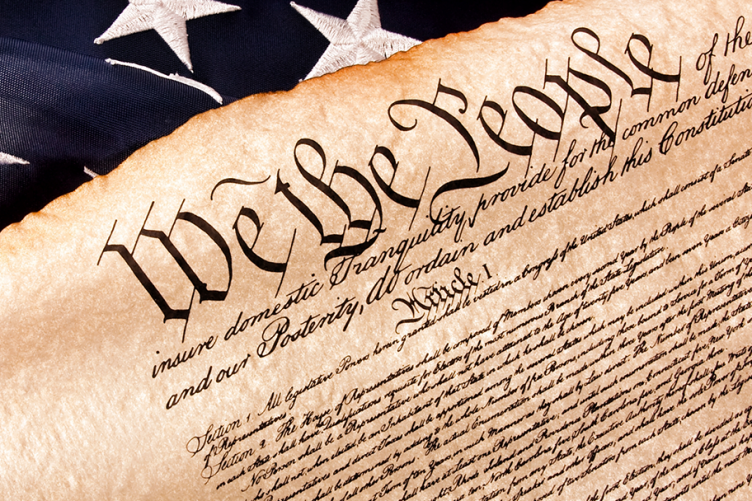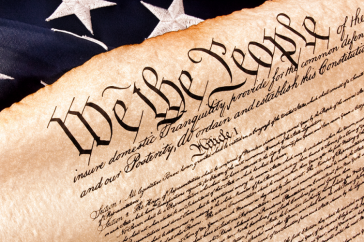
As colleges and universities prepare for Constitution Day next week, commemorating the signing of the U.S. Constitution on Sept. 17, 1787, UNH associate professor of political science Susan Siggelakis reflects on one of the nation's founders, Alexander Hamilton.

Today more people are acquainted with Founding Father Alexander Hamilton than they have ever been, thanks to the amazing popularity of the Broadway musical "Hamilton" by Lin-Manuel Miranda. Hamilton's tumultuous early life on the Caribbean island of Nevis, the rumors about his parentage, his role at the Constitutional Convention, his scandalous affair with Maria Reynolds and possibly his wife’s sister, Angelica Schuyler Church, and assassination by Aaron Burr all make for great theater, especially when set to a hip hop score.
Those who want more information about him should check out Ron Chernow’s excellent biography, "Alexander Hamilton," from which Miranda drew much of his inspiration. Chernow describes a legal case that Hamilton argued as a very young lawyer in 1784, three years before the Constitutional Convention, in the New York Mayor’s court. Hamilton’s arguments presage his analysis of and support for the important concept of judicial review, which he articulated later in The Federalist Number 78. His argument foretells the almost identical one written by Chief Justice John Marshall in the watershed case of Marbury v. Madison (1803). For the first time, a federal court struck down an act of Congress on the grounds of its unconstitutionality.
In 1784, Hamilton was embroiled in a very controversial case in New York City, Rutgers v. Waddington. Although Hamilton was only 27, he was shrewdly analytical and well versed in legal matters, whether American, British or international. A rich widow sympathetic to the Revolution, Elizabeth Rutgers, had abandoned her family’s brewery and alehouse in New York City due its occupation by British forces under General Howe. With the entire works appropriated by the British army, two British merchants, Pierrepont and Waddington, took control of it. It had been pillaged of much of its functioning equipment. The industrious merchants refurbished the works at their own expense and operated it as a going concern, later paying rent to the British army. Near the end of the war and only two days before Washington entered New York in 1783, a fire engulfed the brewery, causing an almost total loss of its value. With the British army expelled, Rutgers sued the pair for back rent, some 8,000 pounds. She did so under a 1783 law passed by the New York Legislature called The Trespass Act. This act was one of several acts that were designed to punish former Tories and sympathizers for their perfidy during the war. The act permitted anyone who supported the Revolution and had evacuated their property due to the hostilities to sue anyone who had occupied, used or damaged such property in their absence.
Hamilton took on the unpopular role of defending the interests of the pair, just two of the reviled many who were now feeling the vengeance of the post-war New York Legislature. In his oral argument, Hamilton maintained that the law of nations legitimated the use of property in occupied territory, as Waddington and Pierrepont had done. His second ground was the 1783 peace treaty, The Treaty of Paris, between the new United States and Britain. The treaty, he argued, was a law of a type superior to the state’s Trespass Act because it had been signed by Congress, a part of the national government under the Articles of Confederation. In staking out these positions, Hamilton urged the judges to rule the Trespass Act as null and void. Both types of law, international and congressional, he asserted, were superior to a state law. In the case of a conflict, the inferior type of law should always be sacrificed to a superior. Judges should shrink the logical exercise of their power. It is routine in their profession to resolve disputes among parties citing different legal authorities.
Hamilton’s argument was not enough to persuade the judges to rule in his favor, though they complimented his lawyerly skills. They acknowledged that the legislature had created a state law that conflicted with a federal treaty; they did not go so far as to void the statute as Hamilton would have liked. Refusing to prove this untested and potentially politically explosive path of elevating judicial power over that of a state legislature, the judges confined their decision to the facts at hand. Waddington should pay Rutgers back rent but only up to and including the time he began to pay the British army. After more legal skirmishing, Rutgers and Waddington settled out of court.
Today, many Americans take it for granted that a court can strike down an act of the legislature on the grounds of it being deemed "unconstitutional" by judges, commonly called judicial review. Yet, as one can see from this case, it has not always been so. Britain’s system of government was one of parliamentary supremacy, as were those of other European nations. This meant that the highest authority in the making of law was the Parliament (legislature), which represented the people’s will. Because no authority was higher than the people, judicial review would be unthinkable in such a system. Nevertheless, the conceptual building blocks, if not the process itself for judicial review, can be traced to English history, through colonial history and early state history as we see here. In fact, it was Alexander Hamilton who, in The Federalist Number 78, provided a foretaste that would become the identical justification for the use of this considerable power written by John Marshall in Marbury. In 78 , among the other Federalist papers he wrote, Hamilton attempted to persuade wary New Yorkers to ratify the Constitution by trying to meet their often sound objections to the proposed new system of government. The entire collection of papers, numbering 85 in total, appeared in New York newspapers in late 1787 and early 1788; they were crafted by Hamilton, James Madison and John Jay. As persuasive pieces, they were intended to be read by citizens and state officials, who then would pressure their delegates to approve the document in the state ratifying convention.
Hamilton laid out the details with the proposed new federal judiciary, including the selection process of these officials and their terms of office, which would be for life. Many New Yorkers generally distrusted judges as being too closely allied with the executive. They had been under British law and were not willing to entrust them with any more powers than necessary. Further, many citizens suspected that these prospective national judges, once ensconced for life terms, would want to seek and enhance their own power at the expense of the legislature, the branch where citizens were represented. Thus, they would try and seek to strike down popularly enacted laws and undo the will of the common people, the electoral majority. Many people feared that these new national judges also would work to destroy whatever state sovereignty was left after the ratification. Even though the power of judicial review was nowhere to be found in the text of the judicial article, Article III in the proposed U.S. Constitution, these many citizens and state officials suspected that the process of judicial review would eventually come into being, once the document was ratified.
Hamilton was challenged to quell the opponents’ concerns. He did so in an elegantly reasoned argument, composed of four basic propositions he knew would probably be acknowledged by even the most fervent, constitutional naysayers. First, the Constitution being framed and ratified by the people in the states reflects the will of all the people. Second, the will of the people is that government be limited. Third, the Constitution, having been made by the people, makes it a superior type of law. Fourth, it is the judicial function to interpret and apply law. Hamilton knew that citizens already had state constitutions, saw them as devices to limit their state governments and viewed these constitutions as superior legal texts. No one could argue about the primary function of lawyers and judges that he so clearly stated. Having presented these four propositions, he expected the reader to inexorably agree with him in concluding that, despite its absence in the Constitution, judicial review was not only a desirable power of the courts but one essential to upholding the operation of the new, constitutional regime. Judges should be expected to and indeed be praised for striking down any statute that conflicted with the higher law of the Constitution. This practice was, according to Hamilton, as constitutional as any of the express powers given to both Congress and the president in the text of the document.
“Considerate men of every description ought to prize whatever will tend to fortify that temper [of integrity and moderation] in the courts; as no man can be sure that he may not be tomorrow the victim of a spirit of injustice, by which he may be a gainer today.”
It worked. New York delegates to its convention finally agreed to ratify the document, composing one — perhaps the most influential — of the nine of the 13 required.
Well before the seminal decision of Marbury v. Madison, we see one of the many experiences that shaped Hamilton’s thinking and his legacy as a member of the founding generation. In other successful Trespass Act cases he later litigated, Hamilton had seen and addressed firsthand the injustices that occur when representative democracy is weaponized to go after unpopular minorities. He knew well the destructiveness of popular majorities, a destructiveness that was not only unjust to individuals but adverse to the functioning of a society that needed unity, rather than division, in order to promote prosperity and security in the aftermath of the Revolutionary War. Only by first positing and getting the citizens to acknowledge some higher authority — the Constitution — limiting the state and federal legislatures and, second, vesting the courts with this power, could governmental threats to citizens’ fundamental rights be minimized in the new constitutional regime.
Hamilton was willing to risk both his reputation and career in protecting the rights of the despised. It is Hamilton’s legacy.
-
Written By:
Susan J. Siggelakis | College of Liberal Arts | susan.siggelakis@unh.edu | (603) 862-1780



















































